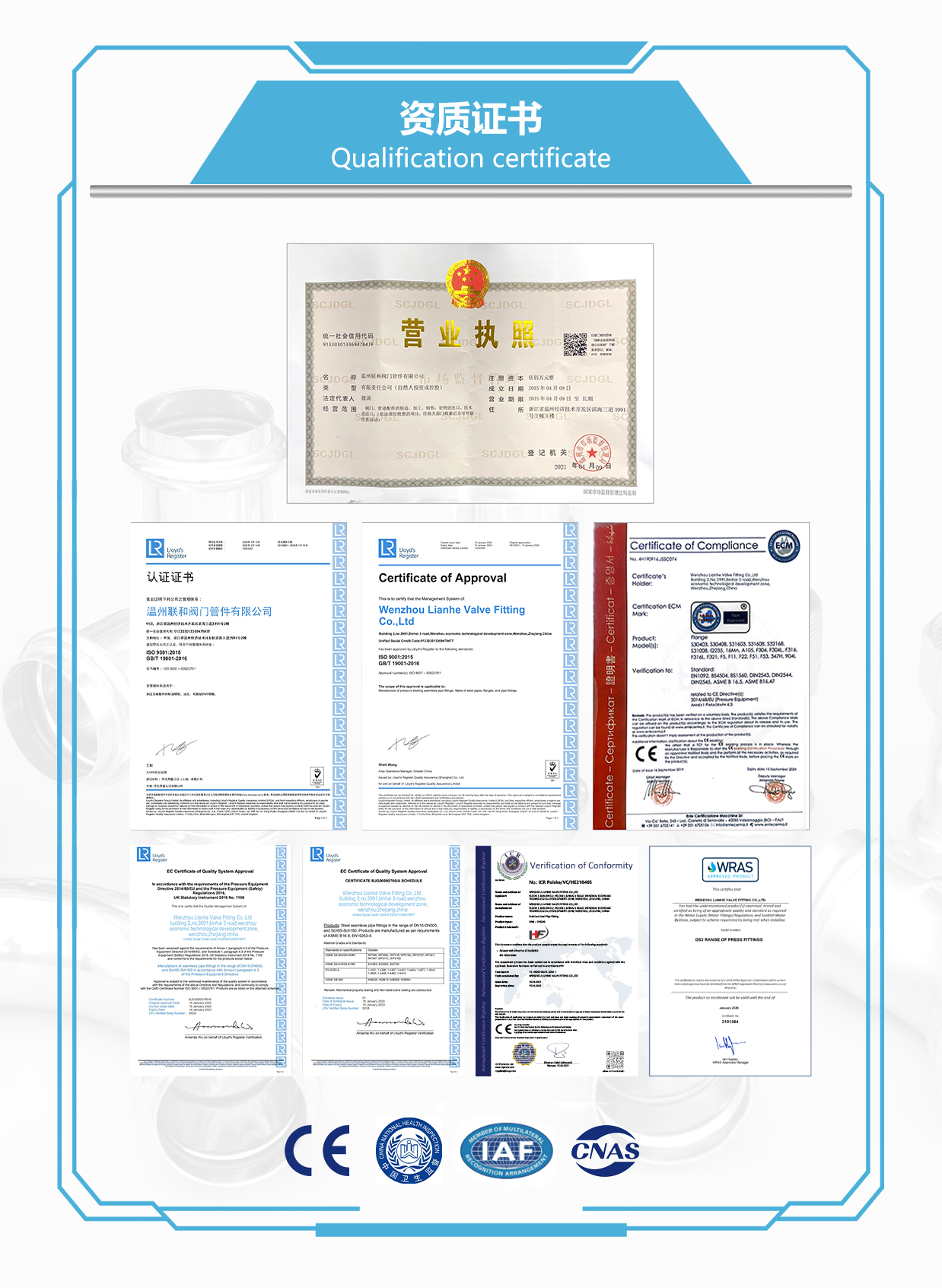Tel: +86-577-86801027 / E-mail: cooper@lianhevf.com
Stainless Steel Fitting
- All
- Product Name
- Product Keyword
- Product Model
- Product Summary
- Product Description
- Multi Field Search
| Availability: | |
|---|---|
| Quantity: | |
The High-Pressure Stainless Steel BW (Butt-Weld) Concentric Reducer is a precision-engineered pipe fitting designed to connect pipes of different diameters in high-pressure, high-temperature systems while maintaining smooth flow and structural integrity. Constructed from seamless 304 or 316 stainless steel, this reducer features a concentric design (uniform wall thickness) and butt-weld ends, making it ideal for applications requiring minimal turbulence and stress concentration.
Premium Seamless Construction:
Manufactured from ASTM A312 stainless steel (304 for general use, 316 for corrosive media), with a minimum tensile strength of 515 MPa and yield strength of 205 MPa.
Seamless body eliminates weak points, rated for working pressures up to 2,500 PSI (schedule 80, 316 stainless steel) and temperatures from -46°C to 815°C.
Concentric Design Advantages:
Uniform diameter reduction (e.g., 6" to 4") ensures symmetrical flow transition, reducing turbulence by 20% compared to eccentric reducers, ideal for liquid-dominated systems.
Smooth internal surface (Ra ≤1.6μm) minimizes pressure loss and prevents sediment buildup in pipelines.
Installation Compliance:
Butt-weld ends with 37.5° bevel meet ANSI B16.25 and ASME B16.9 standards, suitable for GTAW (TIG) and GMAW (MIG) welding processes in critical pipelines.
Available in sizes 1" to 48" NPS, with reducing ratios from 2:1 to 4:1, compatible with schedule 40/80/160 pipes.
Corrosion Resistance:
316 stainless steel variant with 3.5% molybdenum resists pitting in chloride-rich environments (e.g., seawater, brine), with a passivated surface extending service life by 30%.
Ideal for industrial pipelines requiring smooth diameter transitions:
Oil & Gas Transmission: Reducing pipe sizes in high-pressure gas pipelines and refinery process lines, compliant with NACE MR0175 for sour gas service.
Power Generation: Connecting steam turbines to smaller-diameter condensate lines in thermal plants, with 304 stainless steel resisting oxidation at 550°C.
Chemical Processing: Transitioning between reactor inlets/outlets in corrosive environments, meeting cGMP standards for cleanable surfaces in pharmaceutical manufacturing.
Water Treatment: Reducing diameters in high-flow water mains and wastewater pumps, with 316 stainless steel enduring chlorinated water and abrasive particulates.
Q: When should I use a concentric vs. eccentric reducer?
A: Use concentric reducers for liquid-only systems to maintain flow symmetry; eccentric reducers are better for gas-liquid mixtures to prevent air pockets.
Q: Can this reducer be used in vertical pipelines?
A: Yes, concentric reducers are suitable for vertical installations, but ensure proper support to avoid stress on the weld joints.
Q: What is the minimum wall thickness for schedule 160 reducers?
A: Wall thickness varies by size (e.g., 1" schedule 160 has 3.73mm wall), detailed in ASME B16.9 for precise pressure ratings.
Q: Are custom reducing ratios available?
A: Yes, non-standard ratios (e.g., 3" to 1.5") can be manufactured to order, with lead times typically 10-15 business days.

The High-Pressure Stainless Steel BW (Butt-Weld) Concentric Reducer is a precision-engineered pipe fitting designed to connect pipes of different diameters in high-pressure, high-temperature systems while maintaining smooth flow and structural integrity. Constructed from seamless 304 or 316 stainless steel, this reducer features a concentric design (uniform wall thickness) and butt-weld ends, making it ideal for applications requiring minimal turbulence and stress concentration.
Premium Seamless Construction:
Manufactured from ASTM A312 stainless steel (304 for general use, 316 for corrosive media), with a minimum tensile strength of 515 MPa and yield strength of 205 MPa.
Seamless body eliminates weak points, rated for working pressures up to 2,500 PSI (schedule 80, 316 stainless steel) and temperatures from -46°C to 815°C.
Concentric Design Advantages:
Uniform diameter reduction (e.g., 6" to 4") ensures symmetrical flow transition, reducing turbulence by 20% compared to eccentric reducers, ideal for liquid-dominated systems.
Smooth internal surface (Ra ≤1.6μm) minimizes pressure loss and prevents sediment buildup in pipelines.
Installation Compliance:
Butt-weld ends with 37.5° bevel meet ANSI B16.25 and ASME B16.9 standards, suitable for GTAW (TIG) and GMAW (MIG) welding processes in critical pipelines.
Available in sizes 1" to 48" NPS, with reducing ratios from 2:1 to 4:1, compatible with schedule 40/80/160 pipes.
Corrosion Resistance:
316 stainless steel variant with 3.5% molybdenum resists pitting in chloride-rich environments (e.g., seawater, brine), with a passivated surface extending service life by 30%.
Ideal for industrial pipelines requiring smooth diameter transitions:
Oil & Gas Transmission: Reducing pipe sizes in high-pressure gas pipelines and refinery process lines, compliant with NACE MR0175 for sour gas service.
Power Generation: Connecting steam turbines to smaller-diameter condensate lines in thermal plants, with 304 stainless steel resisting oxidation at 550°C.
Chemical Processing: Transitioning between reactor inlets/outlets in corrosive environments, meeting cGMP standards for cleanable surfaces in pharmaceutical manufacturing.
Water Treatment: Reducing diameters in high-flow water mains and wastewater pumps, with 316 stainless steel enduring chlorinated water and abrasive particulates.
Q: When should I use a concentric vs. eccentric reducer?
A: Use concentric reducers for liquid-only systems to maintain flow symmetry; eccentric reducers are better for gas-liquid mixtures to prevent air pockets.
Q: Can this reducer be used in vertical pipelines?
A: Yes, concentric reducers are suitable for vertical installations, but ensure proper support to avoid stress on the weld joints.
Q: What is the minimum wall thickness for schedule 160 reducers?
A: Wall thickness varies by size (e.g., 1" schedule 160 has 3.73mm wall), detailed in ASME B16.9 for precise pressure ratings.
Q: Are custom reducing ratios available?
A: Yes, non-standard ratios (e.g., 3" to 1.5") can be manufactured to order, with lead times typically 10-15 business days.
